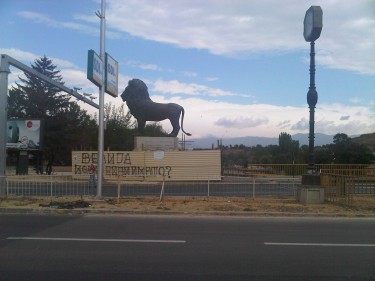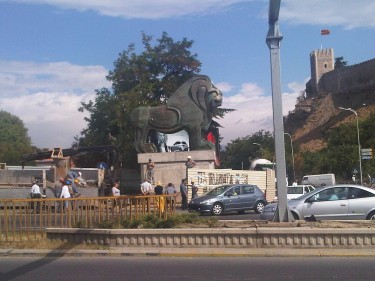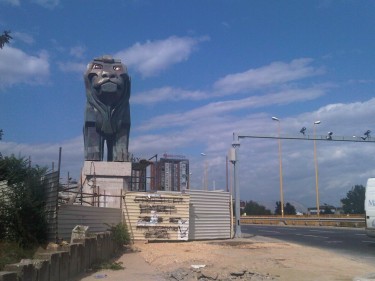The newly-erected statues of four bronze lions on a Skopje bridge attracted the attention of the Macedonian public at the end of August. The initial arrogant refusal of accountability by the statues’ creators overshadowed the questionable artistic achievement related to these publicly funded felines.
 One of the so-called realistic lions, flanked by the recently installed police video cameras and a dysfunctional public clock. Photo: Filip Stojanovski, CC-BY.
One of the so-called realistic lions, flanked by the recently installed police video cameras and a dysfunctional public clock. Photo: Filip Stojanovski, CC-BY.The all-male statues are part of the controversial Skopje 2014 project. The first pair was installed on August 24, and the second on August 31. They immediately incited reactions by social media users. For instance kuzman0v said:
Okay, the lions are here, we only lack: the Hyenas, Timon and Pumbaa. #Skopje2014… [”Hakuna matata“].
Probably the first blogger on the scene was Zoriv, who published [MKD] a small photo-gallery and his impressions, stating that the statues reminded him of his visit to István Szécheny Bridge in Budapest, Hungary, 30 years ago.
…with a delay of about 120 years, Skopje is begging to acquire features common to European cities. Concerning our lions, the future symbol and guardians of Goce Delchev Bridge, I am not overly impressed. The whole “build” seems asymmetrical. The head with the mane is unnaturally tall compared to the rear. The muzzle and the whole head in relation to the body look thinner compared to the natural anatomy of a lion’s head. If the news that these statues really cost EUR 1.2 million is true, I honestly say that for that kind of money another sculptor could have done a much better job.
Whatever, Skopje slowly but radically changes its appearance, which remained stagnant during the 47 years after the catastrophic earthquake. Maybe this is not the best time for such works, when the economic crisis invades every pore of our lives, but it was high time for Skopje at least partly to get a look of a minor and decent European metropolis.
In a comment to this post, antiseparatist said that these “are Bulgarian lions” from Lion’s Bridge in Sofia.
Jokes
As usual, people who found the whole exercise absurd fought back with black humor and satire. Anatomical disproportions of the supposedly “realistic” lions incited a number of jokes, with topics ranging from their large heads to the absence/minuscule size of reproductive organs.
Twitter user apostolov80 used his photo of one of the lions for a multi-layered statement that “the lion has no balls.” Even though careful observers can detect some testicle-like shapes under the tail, echoes of this joke continue to ripple across the net, and some traditional media, like the weekly Fokus and the daily Vest. For instance, VidanaMacedonia alleged [MKD] that the animals were “castrated.” Vest editor Goran Mihajlovski commented [MKD] that such a feature might be quite in line with the true national spirit because the Macedonian idiom for “having balls” (courage) is “having an arse.”
The second pair of lions quickly got compared to Masters of the Universe’s Cringer or something out of Power Rangers toy/cartoon franchises, and their “coming” was announced as an “attack of killer robots.”
 Workers finishing up a so-called postmodernist lion, facing the old Skopje fortress. Photo: Filip Stojanovski, CC-BY.
Workers finishing up a so-called postmodernist lion, facing the old Skopje fortress. Photo: Filip Stojanovski, CC-BY.Lions jokes quickly entered common parlance. Parents protesting the Government’s decision (”due to the economic crisis”) to stop funding meals for handicapped children in a daycare center in Kavadarci pointed to the statues. Facebook users who shared an article [MKD] about this affair also spread the meme that “the Lions ate the kids’ breakfast.”
Kopach also had a point [MKD] in regard to these developments:
Democracy is a social order in which those who rob you address you as “mister” instead of “comrade.”
During the same week the media and the public shared two “important” news: “the lions arrived” and “the money for the Anti-corruption Commission failed [MKD] to arrive.” One might think that the overlap is accidental and random, a mere coincidence of timing. But no, there’s more to this.
Namely, because we gave the money for the lions instead of to the State Commission for Prevention of Corruption, I expect the lions to be responsible for fighting corruption. This struggle should be lead by the mythical creatures of our artists, who are so devoted to the act of creating that they don’t even know how much they earn, and have to employ their economist-spouses to take care of that. It is hard for me to be ironic about the whole situation, because we again displayed tribal consciousness about issues of general, public and national interest. Instead of strengthening the system towards better functioning of the rule of law, providing much-needed justice for all, we strengthen mythology, which the authorities think should provide salvation. Now, when you get stung or hurt by some injustice in our society, do not even think to ask responsibility from the state, the government, the political parties, the institutions: no, no, never. You have been clearly told who protects us: the lions. From now on, if you have any grievance, need to complain or cry, go to those which benefited from the investment of this society. Put all your torments on a piece of paper and file a complaint to the lions of Goce Delchev Bridge, and expect solutions from them. It would be nice if someone would get an idea to put a mailbox on all four lions, where we would be able to file our complaints as gentry. That would be a true service for the citizens!
Transparency
As shown in the video clip [MKD] by Telma TV, taxpayer-funded artists used different tactics to avoid answering how much money they’ve pocketed. Darko Dukovski, who designed the “realistic”–albeit anatomically skewed–lions with his wife Elena, stated [MKD]:
I don’t know about that either. My wife is handling those things. Ha-ha-ha [grinning and laughing].
Konstantin Janev, the author of the “postmodernist” stylized lions, said:
You can check in the legal affair office in the Centar Municipality, I think they have all the documents… Check not only about me, but about all the total expenses…
In his satirical TV show, blogger and journalist Jovan Postoloski shared footage [MKD] of Janev saying that such questions show bad taste and are almost equal to swearing, as well as trying to deflect by asking the reporters about their salaries.
In this post, Pablisher wrote [MKD]:
“The artists” act insulted and deeply surprised when a journalist dares to ask the insolent question about the honorariums for their works within the Skopje 2014 project. They freeze, make inarticulate movements, scratch, roll their eyes…
There’s no reason to act surprised or insulted, the respected “artists” have an obligation to disclose their fees, because they get it from state money, the money of the public, and the public has the right to know that information. Such “artists” are in fact audacious, because they persistently dramatize a regular issue and try to portray it as lack of home education or lack of culture.
If a private donor would order these projects, then the “artists” “may” choose a nondisclosure policy and condemn brutishness. But they have no such choice in the case of Skopje 2014.
I think that this behavior confuses the citizens of Skopje, to the point that they sometimes justify it, saying “the journalists stick their noses in things that are none of their business.” Well, journalists exist to “stick their noses in things that are none of their business.” We saw what happens if journalists do not do that in the last few years – a total system collapse, arbitrariness, corruption scandals, endless nepotism…
Well, dear compatriots, before you start the divisions and defend the “artists,” remember that the money they receive as honorariums come from the taxes we all pay. The journalists, with all their imperfections, are your friends, and you can thank those who are courageous enough to defy the arbitrariness of this nontransparent administration.
There’s only one absolute truth in regard to Skopje 2014: the project is profitable.
It turned out that the Dukovski couple received EUR 15,000, and Janev EUR 12,000 for the statues. (In a televised statement, he said he did not want to disclose the figure because it was too low.) Under pressure, Centar municipality disclosed additional figures three days later: for each pair of lions, EUR 68-74,000 were spent on “material expenses and workers’ fees” and “EUR 1,500 per square meter of relief” for the bases – without informing on the total number of the thus adorned square meters.
The total price for the lions is around EUR 2.3 million, with the lion’s share allegedly going to Fernando Marinelli foundry of Florence, Italy. A joke related to this was that the ‘wealthy’ Macedonia is benevolently helping the ‘poor’ Italian economy to overcome the global economic crisis.

Renee Blodgett is the founder of We Blog the World. The site combines the magic of an online culture and travel magazine with a global blog network and has contributors from every continent in the world. Having lived in 10 countries and explored over 90, she is an avid traveler, and a lover, observer and participant in cultural diversity. She is also the founder of the Magdalene Collection, a jewelry line dedicated to women’s unsung voices and stories, and the award-winning author of the bestselling book Magdalene’s Journey
She is founder of Blue Soul Media and co-founder of Blue Soul Earth as well as the producer and host of the award-winning Blue Soul CHATS podcast, that bridges science, technology and spirituality. Renee also founded Magic Sauce Media, a new media services consultancy focused on viral marketing, social media, branding, events and PR. For over 20 years, she has helped companies from 12 countries get traction in the market. Known for her global and organic approach to product and corporate launches, Renee practices what she pitches and as an active user of social media, she helps clients navigate digital waters from around the world. Renee has been blogging for over 16 years and regularly writes on her personal blog Down the Avenue, Huffington Post, BlogHer, We Blog the World and other sites. She was ranked #12 Social Media Influencer by Forbes Magazine and is listed as a new media influencer and game changer on various sites and books on the new media revolution. In 2013, she was listed as the 6th most influential woman in social media by Forbes Magazine on a Top 20 List.
Her passion for art, storytelling and photography led to the launch of Magic Sauce Photography, which is a visual extension of her writing, the result of which has led to producing six photo books: Galapagos Islands, London, South Africa, Rome, Urbanization and Ecuador.
Renee is also the co-founder of Traveling Geeks, an initiative that brings entrepreneurs, thought leaders, bloggers, creators, curators and influencers to other countries to share and learn from peers, governments, corporations, and the general public in order to educate, share, evaluate, and promote innovative technologies.









